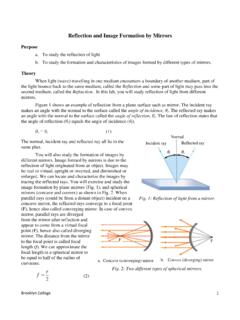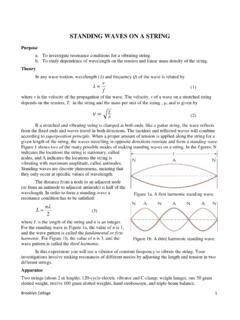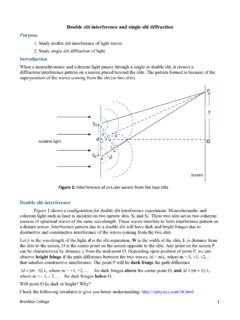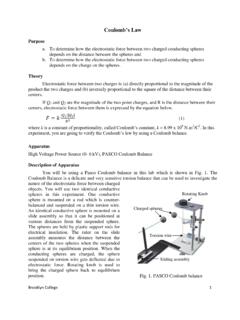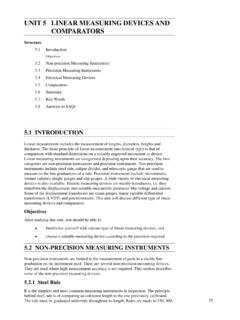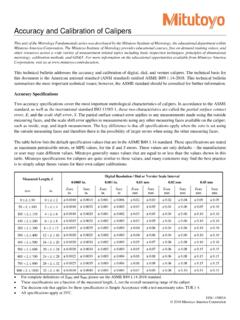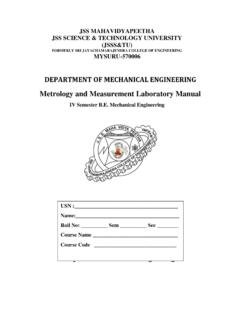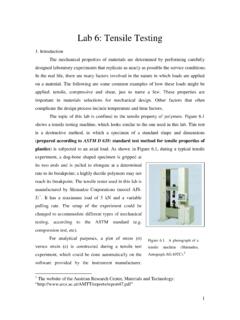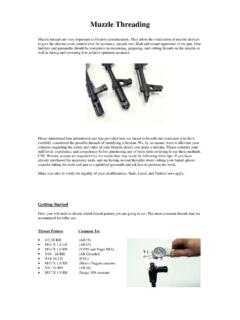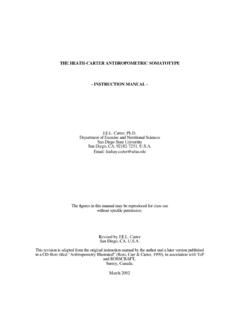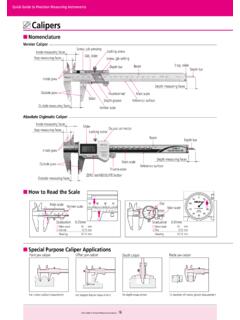Transcription of ARCHIMEDES’ PRINCIPLE
1 Brooklyn College 1 archimedes PRINCIPLE Purpose a. To study buoyant force as a function of submersed volume. b. To verify archimedes PRINCIPLE . c. To use archimedes PRINCIPLE to determine the densities of a solid sample and a liquid sample. Theory a. Buoyancy and archimedes PRINCIPLE When an object is submerged in a fluid, it experiences a buoyant force, B. This buoyant force is the resultant of the pressure-based forces on the surfaces of the submerged object. The pressure is higher at greater depths in the fluid, and thus the buoyant force is directed upward. Figure 1. The buoyant force B is the resultant of the pressure-based forces. archimedes PRINCIPLE , which is derived in your textbooks, states that the magnitude of the buoyant force is equal to the weight of the fluid displaced by the submerged object.
2 B = Wdisplaced-fluid = mdisplaced-fluid g = fluid Vdisplaced-fluid g . (1) If the object is completely submerged in the fluid, the volume of displaced fluid is equal to the volume of the submerged object: Vdisplaced-fluid = Vobject. Then B = fluid Vobject g . (2) If the object is partially submerged, Vdisplaced-fluid = partial volume of the object that is submersed. For a cylindrical solid object of uniform cross section area (A), if the cylinder is immersed in a fluid along the axis of the cylinder and h is the height of the object in the fluid, B = fluid Vimmersed g = fluid Ah g. (3) Brooklyn College 2 b. Effect of buoyancy on measurements of mass When an object is hung from a scale, the reading of the scale, mapparent, is based on the tension in the wire connecting the object to the scale: Wapparent = mapparent g = Twire.
3 Normally, Twire = Wobject = mobject g, and the reading of scale, mapparent, is an accurate measurement of mobject. However, if the object is hung from the scale while submerged in a fluid, then Twire < Wobject because of the contribution of the buoyant force B. Specifically, writing down the balance of the forces on the object (see Figure 2): 0 = Fy = Twire + B Wobject . Figure 2. The equilibrium of forces on an object hanging from a scale while submerged. Since the scale reading is always based on Twire, Wapparent = Twire = Wobject B . B = Wobject Wapparent (4) The apparent weight of a submerged object is less than its actual weight, and the difference between these weights is the buoyant force. What will happen to the apparent weight if the object is partially submerged?
4 In this lab we will measure apparent weight of objects in different conditions to verify archimedes PRINCIPLE as well as use this PRINCIPLE to determine the density of solid and liquid samples. Apparatus Spring scale, aluminum cylinder block, Tall graduated cylinder, laboratory jack, stand, clamp, Triple beam balance, vernier calipers, metal cylinder with copper wire attached, hollow wooden block, beaker, tap water, liquid X, paper towels for drying. Brooklyn College 3 Description of Apparatus You will use a Spring Scale and a laboratory jack as shown in Figure 3(a) to perform part I of the experiment. The spring scale is attched to a clamp on a stand. At the lower end of the spring scale, a metal cylinder is hung. The spring scale reads the apparent weight of the object.
5 The cylinder is slowly submerged in a fluid in a tall graduated cylinder placed on a laboratory jack. The height of the jack can be adjusted by rotating the knob on the side of the jack to change the level of submerge. For other parts of the experiments, you will use a Triple Beam Balance to perform this experiment as shown in Figure 3 (b). It is a mechanical balance. It has a beam which is supported by a fulcrum. On one side of the fulcrum is a pan on which the object is placed. On the other side, the beam is split into three parallel beams. The beam remains balanced when net torque on both sides are equal. In measuring the mass of an object weight blocks on triple beams are adjusted to balance the beam. Remember the torque due to a same force (weight) can be increased by increasing the distance from the fulcrum.
6 The far beam reads only in 100 g increments. The middle beam reads only in 10 g increments. The weight blocks in these two beams must always sit in a "notch". They cannot be placed at arbitrary points on the beam. The weight on the front beam can be placed to read continuously from 0 to 10 grams. The balance should be placed on a leveled surface to use it. Before measuring you should check if the balance is properly zeroed. When all the weight blocks on triple beam are at zero gram position, the mark at the end of the triple beam must stay at Zero. You can adjust a knob at the other end of the beam to bring the mark to zero position. You can measure the mass by putting an object on the hanging pan or hanging the object. There is also a adjustable plateform (see figure) that allows us to measure mass in a liquid.
7 Figure 3. (a) Using the spring scale to measure buoyant force by varying submerge of a cylinder. (b) Using the triple beam balance to measure the apparent mass of a submerged cylinder. 100 g Spring Scale80 g Aluminum SolidTall-form graduated cylinderLaboratory JackClampLaboratory StandCalipersAdjustable plateform Hanging pan (a) (b) Brooklyn College 4 Procedure Part I. Studying buoyant force with partially immersed volume In this part of the experiment, you will study how the buoyant force varies when a solid object is slowly submerged into a liquid. 1. Hang the solid aluminum block on the spring scale. 2. Fill the graduated cylinder to exactly 60 mL with water and put it on the laboratory jack. Adjust the height of the jack so that the top of the graduated cylinder is well below the hanging object on the spring scale.
8 3. Now, align the graduated cylinder so that the aluminum block does not touch the cylinder wall when moving down. Adjust the laboratory jack so that the mass hangs just above the water level (not touching the water). 4. Record the reading on the spring scale in the Table 1 for the initial value (0 mL). 5. Adjust the laboratory jack to submerge the aluminum mass in the water until there is a 4 mL change in volume on the graduated cylinder. Record the corresponding reading from the spring scale in the Table 1. 6. Repeat the previous step with 4 mL increments until the entire block is submerged. Now, slowly lower the jack and remove the cylinder with liquid and put away carefully. Part II. Verifying archimedes PRINCIPLE 7. Measure the diameter and height of the metal cylinder with the calipers.
9 You will use these values to determine the volume of the cylinder. 8. Use the triple beam balance to measure the mass of the metal cylinder. (Do not remove the hanging pan when making this measurement; instead, make sure that the scale is properly zeroed when the empty pan is hanging.) Attach the metal cylinder to the scale, using the cylinder s wire. Determine the mass of the cylinder from the scale and record in Table 2. 9. Place a beaker with tap water on the adjustable platform above the scale pan (see figure), and hang the metal cylinder so that it is completely submerged in the water. Record the reading of the triple beam balance for the hanging submerged cylinder. Remove the cylinder and dry it. Part III. Determining the volume and density of the wooden block using archimedes PRINCIPLE 10.
10 If you just put a wooden block in water, it will float. Why do you think it floats on water? In order to submerge the wooden block into water, place the hollow wooden block in the hanging pan of the triple beam balance, and determine its mass. Record your measurement in Table 3. Note that the block has a complicated shape, so that its volume would be difficult to determine using the calipers. 11. Place the lower end of the cylinder into the hole in the block. Suspend the cylinder-block combination from the triple beam balance while it is fully submerged in water. Record the reading of the triple beam balance for the hanging submerged cylinder-block combination. From your previously measured mass of the metal cylinder, you can determine mass of the wooden block. Brooklyn College 5 Part III.
